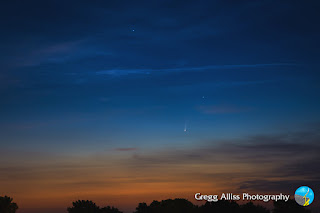NEOWISE Makes Its Appearance
Tuesday, July 7, 2020
The Comet NEOWISE (Near Earth Object Wide-Field Infared Survey Explorer) C/2020 F3 was discovered on March 27, made an unmolested swing around the sun on July 3, and is apparently brightening as it heads back out into space. Unlike the recent comets ATLAS and SWAN which fizzled out and were disappointments, NEOWISE looks to provide some decent viewing opportunities in the next couple of weeks. I headed out to the nearby Bowman Meadows housing development just south of Boyson Road in Marion, Iowa during the pre-dawn hours of Tuesday, July 7, 2020 to attempt to capture the comet. My camera was positioned on a high construction hillock of dirt, facing northeast. Challenging my view was a nearly full moon, streaks of cirrus clouds with contrails, high humidity, and light pollution. As a matter of fact, the entire time I was there I could not make out the comet with the naked eye, nor could I locate it with binoculars. Camera long exposures do wonders, however, and it was captured in this way! The image above was photographed at 4:06 am CDT and is a 13 second exposure at f/5.6, ISO 160 and 28mm focal length. The comet is dimly seen at lower left. Also shown is the 0.06 magnitude star Capella in the constellation Auriga (upper left), the Pleiades star cluster at upper right, -4.47 magnitude planet Venus at lower right, with the 0.84 magnitude star Aldebaran in the constellation Taurus below it. The bright structure at lower right is a transformer complex just east of Bowstring Drive and Alburnett Road.
4:26 am. Comet NEOWISE is positioned at center in this image, a 13 second exposure at f/5.6, ISO 160 and 36mm focal length. The star above left of the comet is the 1.87 magnitude Menkalinan, and at top is Capella.
4:32 am. 15 second exposure at f/7.1, ISO 250, 52mm focal length. The star above right of NEOWISE is 2.62 magnitude Theta Aurigae, near top is Menkalinan.
4:42 am. The brightening pre-dawn sky was beginning to dim the comet (sunrise was at 5:38 am). This is a 20 second exposure at f/9, ISO 125, 18mm focal length. The bright star at top is Capella, the bright planet at right is Venus, with the star Aldebaran below it. Air temperature was 71 degrees F. I was not "bugged" by insects. Nikon D7200 DSLR camera.









0 comments:
Post a Comment